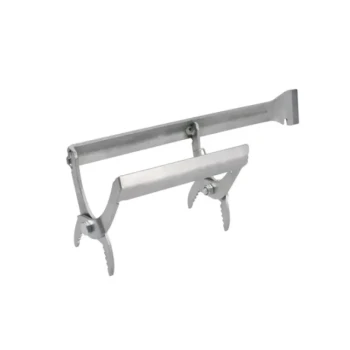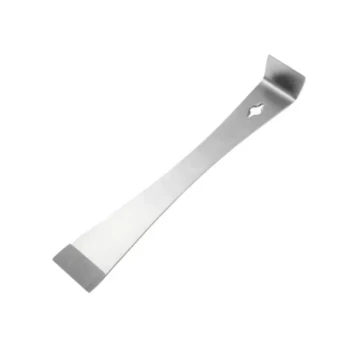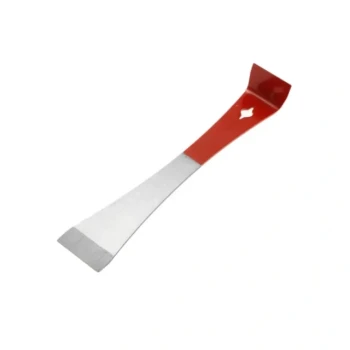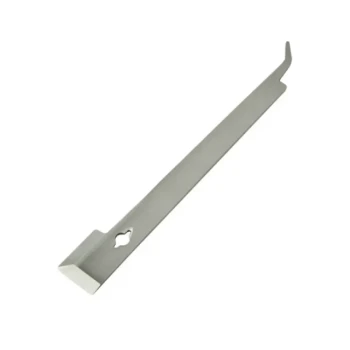By a significant margin, the most common beehive used worldwide is the Langstroth hive. First patented in 1852, its revolutionary design of vertically stacked boxes and individually removable frames became the global standard. This modularity allows beekeepers to inspect the colony, manage space, and harvest honey with minimal disturbance to the bees.
The Langstroth hive's dominance is not due to tradition, but to its core design principle: providing a standardized, scalable system that makes hive management efficient for both small-scale hobbyists and large commercial operations.
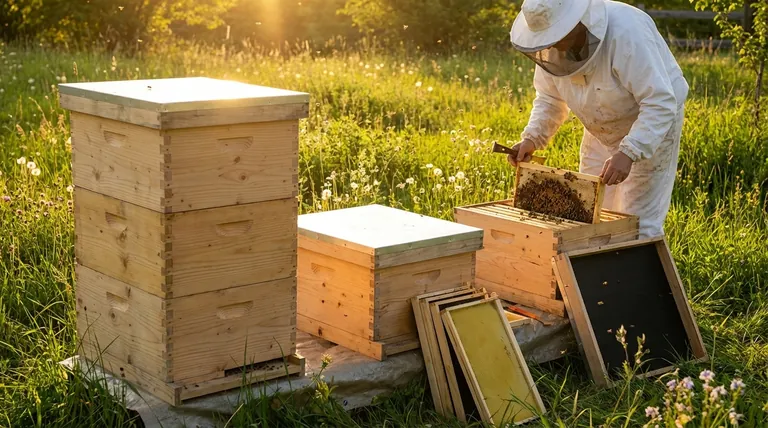
The Anatomy of a Langstroth Hive
To understand why the Langstroth is the standard, you must first understand its simple yet brilliant components. The entire system is built around a key discovery about bee behavior.
The Core Principle: "Bee Space"
The genius of the Langstroth design is its precise adherence to "bee space"—an interval of roughly 3/8ths of an inch (9.5mm). Bees will leave a space of this size open for movement but will fill any smaller gap with propolis (a resinous glue) and build comb in any larger gap.
Langstroth hives are built to maintain this exact spacing around every frame, which is why they can be removed so easily.
The Modular Box System (Supers)
A Langstroth hive consists of a stack of boxes, often called "supers." They come in different depths for different purposes.
- Deep Boxes: These are typically used as the bottom-most chambers for the queen to lay eggs and for the colony to raise brood.
- Medium or Shallow Boxes: These lighter, shorter boxes are placed on top for the bees to store surplus honey.
The Critical Innovation: Removable Frames
Inside each box hang eight or ten vertical frames. Bees build their honeycomb within these wooden or plastic frames.
This is the most important feature. It allows a beekeeper to slide out a single frame to inspect the queen's health, check for disease, or see if honey is ready for harvest without breaking or disturbing the rest of the colony's comb.
Why the Langstroth Dominates the Industry
The Langstroth's design solved the biggest challenges of pre-modern beekeeping, making it incredibly practical and efficient.
Unmatched Standardization
Because the Langstroth is the industry standard, parts are interchangeable and widely available. Whether you need a new frame, box, or lid, you can easily find compatible equipment from virtually any beekeeping supplier. This is a massive advantage for new beekeepers.
Efficiency in Management
The ability to remove individual frames makes essential beekeeping tasks straightforward. Health inspections, disease treatment, and space management (adding or removing boxes) can be done with precision and minimal disruption to the colony's work.
Scalability for All Levels
The same fundamental system works for a hobbyist with one hive in their backyard and a commercial pollinator with thousands of hives. The principles remain the same; only the scale changes.
Understanding the Trade-offs: 8-Frame vs. 10-Frame
While the Langstroth design is the standard, you must still choose between two common sizes: 8-frame and 10-frame.
The 10-Frame Standard
Most experts recommend a 10-frame hive for beginners. Its popularity ensures components are easy to find and often cheaper. The larger size gives the bees more room for brood and honey, making it slightly more forgiving if you are late to add a new box.
The primary drawback is weight. A deep 10-frame box full of honey and brood can weigh 80-90 pounds (36-41 kg), making it very difficult for some people to lift.
The 8-Frame Alternative
The 8-frame hive is dimensionally identical to the 10-frame in height and length, but it is narrower. Its main advantage is significantly lighter weight. A full deep box typically weighs around 60-70 pounds (27-32 kg), a manageable difference for many.
The trade-off is that the colony has less space, which means you may need to add new supers more frequently during a strong nectar flow to prevent the hive from swarming.
Making the Right Choice for Your Goal
Selecting a hive type is the first major decision in your beekeeping journey. The Langstroth is almost certainly the correct system, but the size depends on your physical ability and management style.
- If your primary focus is simplicity and finding resources easily: Choose the 10-frame Langstroth, as it is the most common configuration and offers the colony more space.
- If you have any concerns about lifting heavy weight: The 8-frame Langstroth is a superior choice, trading slightly more frequent management for much more manageable boxes.
Understanding this fundamental choice is the first step toward a successful and enjoyable beekeeping experience.
Summary Table:
| Feature | Description | Benefit |
|---|---|---|
| Modular Boxes (Supers) | Stackable boxes of varying depths (deep, medium, shallow). | Allows for easy colony expansion and space management. |
| Removable Frames | 8 or 10 frames per box where bees build comb. | Enables inspection, disease checks, and honey harvesting without destroying the hive. |
| 'Bee Space' Principle | Maintains a precise 3/8-inch gap around frames. | Prevents bees from gluing frames together with propolis, making management efficient. |
| Industry Standardization | Interchangeable parts from virtually any supplier. | Simplifies sourcing and repairs for both hobbyists and commercial operations. |
Ready to build or scale your apiary with the industry's most reliable equipment?
At HONESTBEE, we supply durable, precision-made Langstroth hive components and beekeeping supplies to commercial apiaries and equipment distributors through our wholesale-focused operations. Our standardized equipment ensures compatibility and efficiency for your beekeeping success.
Contact HONESTBEE today to discuss your wholesale needs and get a quote!
Visual Guide

Related Products
- Langstroth Bee Hives Bee Keeping Box for Beginners Beekeeping
- HONESTBEE Professional Multi-Functional Hive Tool with Ergonomic Wood Handle
- Ergonomic Two Person Foldable Hive Lifter
- HONESTBEE Advanced Ergonomic Stainless Steel Hive Tool for Beekeeping
- Multi-Function Plier-Style Frame Grip Hive Tool
People Also Ask
- What are the different types of beehive boxes available? Choose the Right Hive for Your Apiary
- What are the key features of the Langstroth beehive? A Guide to the Standard for Modern Beekeeping
- Should a beginner try a different type of hive? Start with a Langstroth for a solid foundation.
- How does the ease of access differ between 8-frame and 10-frame hives? Choose the Right Hive for Your Body
- Why are Langstroth hives recommended for beginners? Unmatched Support & Standardization




